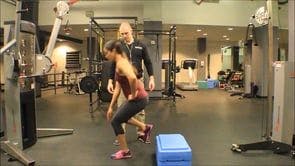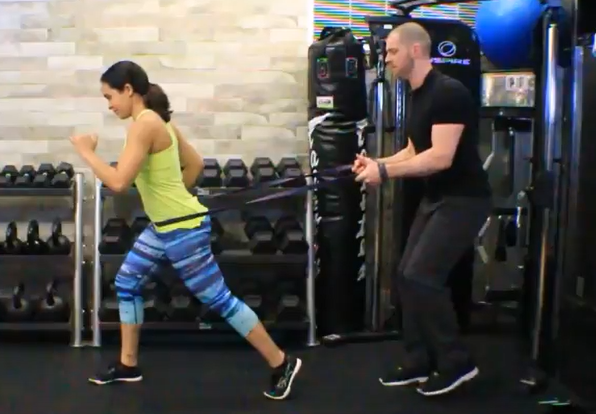Research Review: Hip Strengthening Program on the Mechanics During Running and Single-leg Squat
By David Chessen DPT, PT, MBA, CSCS
Edited by Brent Brookbush DPT, PT, COMT, MS, PES, CES, CSCS, ACSM H/FS
Original Citation: Willy, R. W., & Davis, I. S. (2011). The effect of a hip-strengthening program on mechanics during running and during a single-leg squat. Journal of orthopaedic & sports physical therapy, 41(9), 625-632. ABSTRACT
Why the Study is Relevant: Abnormal hip and knee mechanics have been correlated with running-related injuries (1 - 7). Further several studies have shown that increasing hip strength may improve lower extremity mechanics (8 - 10). This 2011 study from the University of Delaware investigated whether a hip strengthening program affects mechanics during running and single-leg squats in female runners. The findings suggest that the program did not change abnormal mechanics during running, but did increase hip strength and improve abnormal mechanics during single-leg squats.

Study Summary
| Study Design | Randomized controlled single-blinded trial. |
| Level of Evidence | IIB evidence from at least one other type of quasi-experimental study. |
| Subject Characteristics | Training Group Demographics
Control Group Demographics
Inclusion Criteria:
Exclusion Criteria:
|
| Methodology | A priori power analysis determined the study sample size:
Potential participants underwent a baseline screening to determine whether they met the inclusion criteria of abnormal hip mechanics during running:
Participants were assigned to either a training (TR) or control (CON) group. Group assignment was randomized to ensure matching for age and weekly running distance. Peak isometric hip abduction (HABDS) and peak hip external rotation (HERS) strength were measured with a handheld dynamometer.
Participants in the TR group took part in a hip strengthening and movement re-education program for the hip abductors and external rotators 3 times a week for 6 weeks.
Participants in the CON group did not take part in the hip strengthening or re-education program. All participants maintained their weekly running distance throughout the study. At the end of the 6-weeks all participants took part in a strength and motion analysis. |
| Outcome Measures | Mixed model, 2-way analysis of variance (ANOVA) was used to analyze strength measures and peak joint angles. Post hoc dependent t-tests were conducted on normally distributed variables with significant findings in the areas of hip abduction and external rotation. |
| Results | Independent t-tests did not reveal differences between the TR and CON groups for age, weekly running distance and BMI at baseline. Significant interaction over time was noted for both strength measures:
All running data were normally distributed:
All single-leg squat data were normally distributed:
|
| Our Conclusions | The researchers' conclusion that strength-training alone is unlikely to improve the high velocity mechanics specific to running. reinforces the importance of an integrated program that includes higher velocity techniques (reactive activation) and appropriately selected activities to enhance transference to daily activity (integrated exercise). Mechanics during the single-leg squat improved significantly; however, this exercise was also performed as part of the hip-strengthening program. |
| Conclusions of the Researchers | Despite significant gains in strength, no changes were seen in hip mechanics during running. Strength training alone may not be adequate to alter abnormal movement mechanics of the lower extremities during running. |

Resisted Walking - Example of a lower extremity "Integration Exercise"
Review & Commentary
This study contributed to the body of research investigating the effect of exercise interventions on lower extremity mechanics (2, 3, 9, 10). The exercises used in this study included side lying leg raise, clamshells , standing isometric hip abduction, external rotation, and pelvic hike. This hip strengthening program was not sufficient to alter lower extremity mechanics during running; however, it did improve the mechanics observed during a single leg squat. Human movement professionals should consider the amount of strength, motor control and the velocity of activities that the patient/client will be returning to, or is training for when designing a program.
The study had many methodological strengths, including:
- The authors performed an a priori power analysis before the study to determine the number of participants needed for strong statistical significance to the findings.
- The training program was long enough to result in muscle hypertrophy, as opposed to other shorter studies which may only attribute strength gains to neuromuscular adaptation.
- Both standardized tests (MMT) and kinematic video analysis were used to assess outcome measures.
- By using the single leg squat and running, this research was able to show how a change in one movement pattern may not carry-over to higher intensity activities that are part of the client/patient's daily activity/sport.
Weaknesses that should be noted prior to clinical integration of the findings include:
- The study was restricted to female participants; dditional studies should include male participants.
- Muscle testing was limited to hip abduction and external rotation. Testing specific to muscles hypothesized as weak, with the addition of EMG data, may have alluded to more refined exercise selections.
- No range of motion (ROM) data was collected. This ignores the impact mobility restrictions may have on kinematics and/or strength.
- There was no data collected and no interventions directed at improving foot/ankle kinematics. This may have resulted in additional impairments reducing the impact of the interventions selected.
- Although the participants exhibited abnormal mechanics, they were asymptomatic. Further research should include participants with hip and/or knee-related conditions, such as patellofemoral pain syndrome (PFPS).
How This Study is Important:
This study demonstrates that a program must include specific and sufficiently challenging exercise to result in adaptations that transfer to activities of daily living and sport. This may include additional progressions of exercise, loads and volume of exercise achieved, as well as higher velocity and integrated movement patterns that may result in higher transference to sport specific activities.
How the Findings Apply to Practice:
Females exhibiting a pattern of increased hip adduction and internal rotation during running may benefit from a 6-week hip strengthening program. However, improvements observed during exercise related tasks may not transfer to running. It is likely that additional techniques will be needed to optimize motion during these higher velocity tasks.
How does it relate to Brookbush Institute Content?
The Brookbush Institute (BI) uses an integrated approach to address postural dysfunction and movement impairments . In this study, participants presented with the sign "Knees Bow In ," a commonly observed sign during the Overhead Squat Assessment (OHSA) . This sign may be associated with Lumbo-Pelvic-Hip Complex Dysfunction , and/or Lower Extremity Dysfunction (LED) .
Although the exercises recommended in this study are commonly used by BI, "reactive activation" and "integration techniques" would also be added to create an "activation circuit ". The intent of activation circuits is to ensure that corrective intervention leads to change in the quality of movement both during exercise, as well as higher velocity activities. Further, BI recommends mobility assessment of all relevant joints, and performing the techniques implied by a mobility assessment before performing exercises like those used in this study.
This study found that low velocity activation and strengthening exercises are not sufficient to alter lower extremity mechanics during running. Using BI content, the human movement professional may consider additional techniques to incorporate into a program designed for this goal:
The following videos illustrate sample techniques for "reactive activation" and "subsystem integration":
Gluteus Maximus Reactive Activation
Gluteus Maximus Reactive Activation Progressions
Resisted Walking
Single Leg Squat to Bilateral Cable Pull Down
Bibliography:
- Dierks, T. A., Manal, K. T., Hamill, J., & Davis, I. S. (2008). Proximal and distal influences on hip and knee kinematics in runners with patellofemoral pain during a prolonged run. journal of orthopaedic & sports physical therapy, 38(8), 448-456.
- Ferber, R., Kendall, K. D., & Farr, L. (2011). Changes in knee biomechanics after a hip-abductor strengthening protocol for runners with patellofemoral pain syndrome. Journal of athletic training, 46(2), 142-149.
- Snyder, K. R., Earl, J. E., O’Connor, K. M., & Ebersole, K. T. (2009). Resistance training is accompanied by increases in hip strength and changes in lower extremity biomechanics during running. Clinical Biomechanics, 24(1), 26-34.
- Mascal, C. L., Landel, R., & Powers, C. (2003). Management of patellofemoral pain targeting hip, pelvis, and trunk muscle function: 2 case reports. Journal of Orthopaedic & Sports Physical Therapy, 33(11), 647-660.
- Teng, H. and Powers, C. (2016) Hip Extensor Strength, Trunk Posture, and Use of the Knee-Extensor Muscles During Running. Journal of Athletic Training, 51(8), 000-000
- Noehren B, Hamill J, Davis I. Prospective Evidence for a Hip Etiology in Patellofemoral Pain. Medicine & Science in Sports & Exercise. 2013;45(6):1120–1124
- Ireland, ML., Wilson, JD., Ballantyne, BT., Davis, IM. (2003). Hip Strength in Females With and Without Patellofemoral Pain. J Orthop Sports Phys Ther 2003. 33: 671-676
- Ramskov, D., Barton, C., Nielsen, R. O., & Rasmussen, S. (2015). High Eccentric Hip Abduction Strength Reduces the Risk of Developing Patellofemoral Pain Among Novice Runners Initiating a Self-Structured Running Program: A 1-Year Observational Study. journal of orthopaedic & sports physical therapy, 45(3), 153-161
- Snyder, K. R., Earl, J. E., O’Connor, K. M., & Ebersole, K. T. (2009). Resistance training is accompanied by increases in hip strength and changes in lower extremity biomechanics during running. Clinical Biomechanics, 24(1), 26-34.
- Bell, D. R., Oates, D. C., Clark, M. A., & Padua, D. A. (2013). Two-and 3-dimensional knee valgus are reduced after an exercise intervention in young adults with demonstrable valgus during squatting. Journal of athletic training,48(4), 442-449.
© 2017 Brent Brookbush
Questions, comments, and criticisms are welcomed and encouraged


